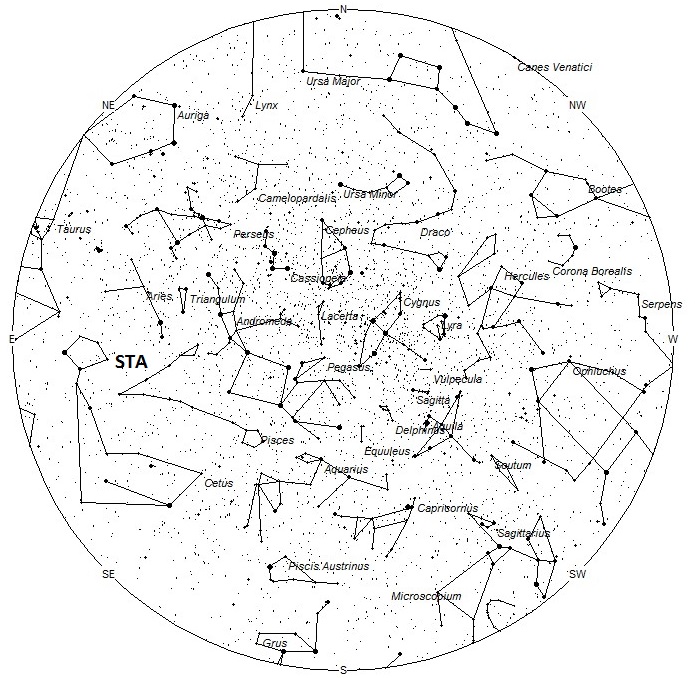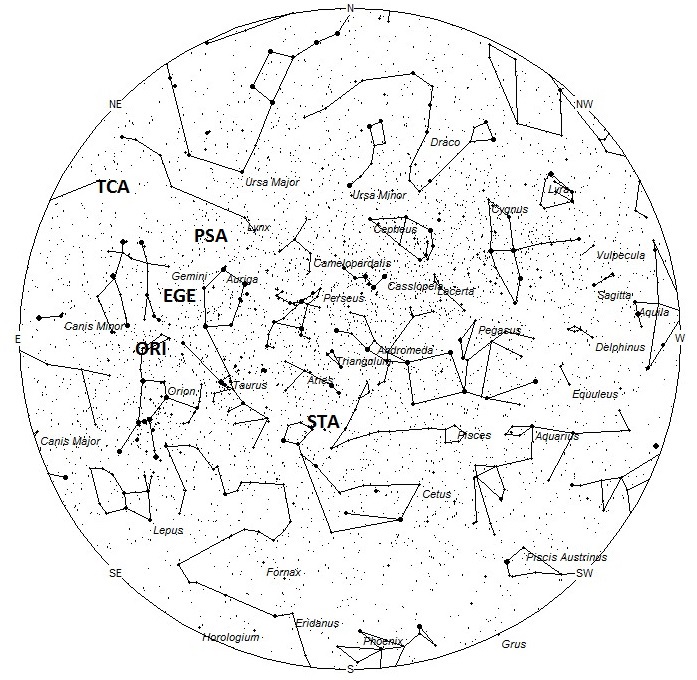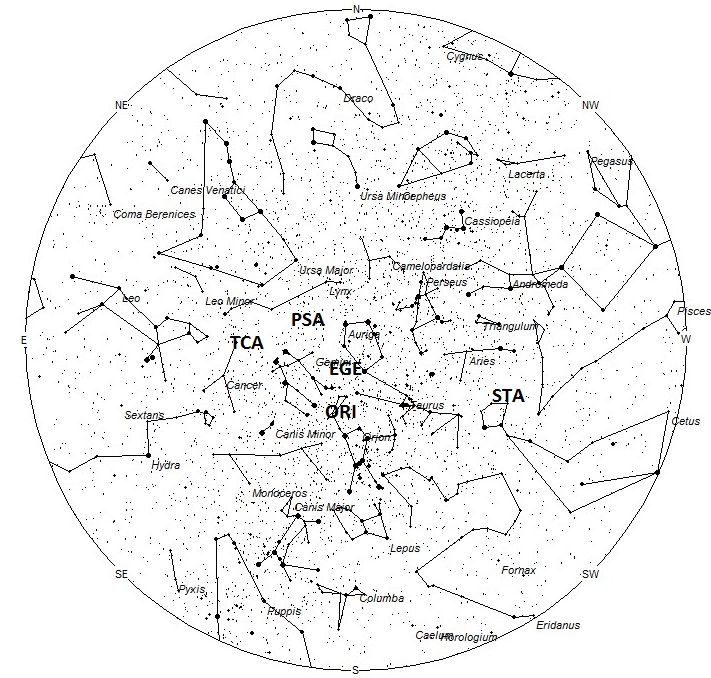During this period the moon reaches its full phase on Friday October 18th. At this time the moon lies opposite of the sun and will be above the horizon most of the night. This weekend the waxing gibbous moon will set shortly after midnight, allowing the remaining morning hours to be free of interfering moonlight. This window of darkness shrinks with each passing night until the moon remains above the horizon all night long late in this period. The estimated total hourly meteor rates for evening observers this week is near 3 for observers located in the northern hemisphere and 2 for those viewing south of the equator. For morning observers the estimated total hourly rates should be near 22 as seen from mid-northern latitudes and near 15 for observers viewing from tropical southern latitudes. Evening rates are reduced due to moonlight. The actual rates will also depend on factors such as personal light and motion perception, local weather conditions, alertness and experience in watching meteor activity. Note that the hourly rates listed below are estimates as viewed from dark sky sites away from urban light sources. Observers viewing from urban areas will see less activity as only the brightest meteors will be visible from such locations.
The radiant (the area of the sky where meteors appear to shoot from) positions and rates listed below are exact for Saturday night/Sunday morning October 12/13. These positions do not change greatly day to day so the listed coordinates may be used during this entire period. Most star atlases (available at science stores and planetariums) will provide maps with grid lines of the celestial coordinates so that you may find out exactly where these positions are located in the sky. A planisphere or computer planetarium program is also useful in showing the sky at any time of night on any date of the year. Activity from each radiant is best seen when it is positioned highest in the sky, either due north or south along the meridian, depending on your latitude. It must be remembered that meteor activity is rarely seen at the radiant position. Rather they shoot outwards from the radiant so it is best to center your field of view so that the radiant lies at the edge and not the center. Viewing there will allow you to easily trace the path of each meteor back to the radiant (if it is a shower member) or in another direction if it is a sporadic. Meteor activity is not seen from radiants that are located below the horizon. The positions below are listed in a west to east manner in order of right ascension (celestial longitude). The positions listed first are located further west therefore are accessible earlier in the night while those listed further down the list rise later in the night.
The following sources of meteoric activity are expected to be active this week:
The Southern Taurids (STA) are currently active from a radiant located at 02:20 (035) +09. This position lies on the Cetus/Aries border, just northwest of the 4th magnitude star known as Xi 2 Ceti. These meteors may be seen all night long but the radiant is best placed near 0200 LDT when it lies on the meridian and is located highest in the sky. Rates at this time should be near 3 per hour regardless of your location. With an entry velocity of 29 km/sec., the average Southern Taurid meteor would be of slow velocity.
The Orionids (ORI) are active from a radiant at 05:56 (089) +16, which places it in northeastern Orion, 8 degrees north of the 1st magnitude orange star known as Betelgeuse (Alpha Orionis). This area of the sky is best placed in the sky near 0500 LDT, when it lies highest above the horizon. Rates this week should be near 5 per hour no matter your location. With an entry velocity of 67 km/sec., most activity from this radiant would be of swift speed.
Recent analysis of the IMO video database has shown that the Epsilon Geminids (EGE) are active as early as September 22. The current radiant position would be located near 06:24 (096) +30, which places it in southern Auriga, just 2 degrees northeast of the 4th magnitude star known as Kappa Aurigae. This area of the sky is best placed in the sky during the last hour before dawn, when it lies highest above the horizon in a dark sky. Current rates should be near 2 per hour as seen from the northern hemisphere and near 1 when view south of the equator. With an entry velocity of 70 km/sec., most activity from this radiant would be of swift speed.
The Psi Aurigids (PSA) were discovered among the radiants found by the IMO network of video cameras. This weak shower is active from October 8-18, which maximum activity occurring on the 15th. The radiant is currently located at 07:12 (108) +44. This position lies on the Lynx/Auriga border, 12 degrees northwest of the 2nd magnitude star known as Castor (Alpha Geminorum). This area of the sky is best placed in the sky during the last hour before dawn, when it lies highest above the horizon in a dark sky. Current rates should be near 1 per hour as seen from the northern hemisphere and less than 1 as seen from south of the equator. With an entry velocity of 68 km/sec., most activity from this radiant would be of swift speed.
The Tau Cancrids (TCA) are active from October 9-25, with maximum activity occurring near the 17th. This shower was discovered by Peter Jenniskens and verified by IMO video data. The radiant currently located at 08:40 (130) +29. This position lies in northern Cancer, close to the 4th magnitude star known as Iota Cancri. This area of the sky is best placed in the sky during the last hour before dawn, when it lies highest above the horizon in a dark sky. Current rates should be near 1 per hour as seen from the northern hemisphere and less than 1 as seen from south of the equator. With an entry velocity of 69 km/sec., most activity from this radiant would be of swift speed.
As seen from the mid-northern hemisphere (45N) one would expect to see approximately 10 sporadic meteors per hour during the last hour before dawn as seen from rural observing sites. Evening rates would be near 2 per hour. As seen from the tropical southern latitudes (25S), morning rates would be near 7 per hour as seen from rural observing sites and 1 per hour during the evening hours. Locations between these two extremes would see activity between the listed figures. Moonlight reduces the number of meteors seen during the evening hours during this period.
The table below presents a list of radiants that are expected to be active this week. Rates and positions are exact for Saturday night/Sunday morning except where noted in the shower descriptions.
| SHOWER | DATE OF MAXIMUM ACTIVITY | CELESTIAL POSITION | ENTRY VELOCITY | CULMINATION | HOURLY RATE | CLASS |
| RA (RA in Deg.) DEC | Km/Sec | Local Daylight Time | North-South | |||
| Southern Taurids (STA) | Oct 10 | 02:20 (035) +09 | 29 | 02:00 | 3 – 3 | II |
| Orionids (ORI) | Oct 22 | 05:56 (089) +16 | 67 | 05:00 | 5 – 4 | I |
| Epsilon Geminids (EGE) | Oct 22 | 06:24 (096) +30 | 70 | 06:00 | 2 – 1 | II |
| Psi Aurigids (PSA) | Oct 15 | 07:12 (108) +44 | 68 | 07:00 | 1 – <1 | IV |
| Tau Cancrids (TCA) | Oct 17 | 08:40 (130) +29 | 69 | 09:00 | 1 – <1 | IV |
 American Meteor Society
American Meteor Society



pretty sure I saw a meteorite over Edgewater, MD. I thought is was from a firework, but no sound around. It was a strand of sparks.
I believe I saw a meteor in passing over Daly City, CA this morning about 6:40 am
I’m sure I saw the same one. Was Looking west from Sacramento about the same time so it had to be.
We were outside at 10:00pm ‘ish, and in okotoks ab, canada, to the west, south west now, there was “shooting star”, I would like to know more about it, the kids were amazed , anyone?
Christine and All,
Shooting stars are actually meteors. These objects are tiny bits of stone, metal, or ice that collide with the Earth’s atmosphere. They would not be visible except for the fact that they are traveling at very high velocities, which create the luminous streaks we see as shooting stars. Meteors occur on every night of the year but there are better times of the year to see them. From the northern hemisphere, autumn is the best time to see meteors, especially during the hours between midnight and dawn.
Robert Lunsford
American Meteor Society